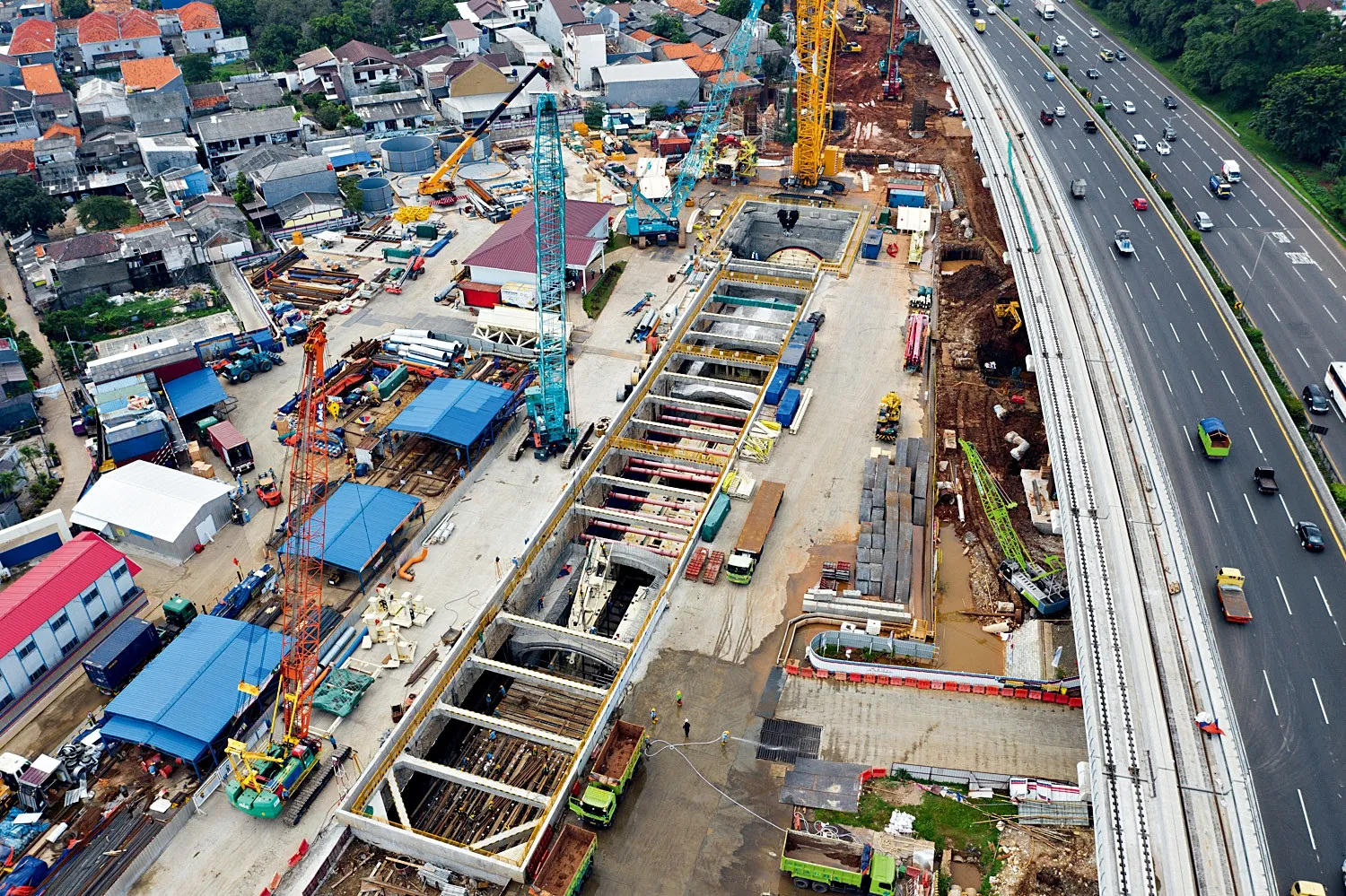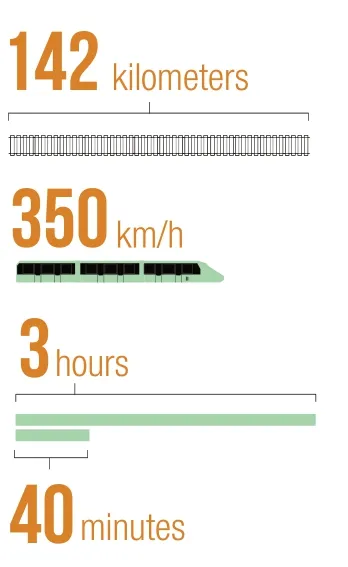FLAGSHIP RAIL
By Wang Fengjuan
The Jakarta-Bandung high-speed railway will be a sure-fire boon for the Indonesian economy

China High Speed Railway Fast Track Exhibition in Senayan City mall, Jakarta, Indonesia, February 14, 2013.
O nMay 29, 2019,representatives of PT Kereta Cepat Indonesia China (KCIC), a joint venture established by Chinese and Indonesian consortia to develop the Jakarta-Bandung high-speed railway, waved goodbye to a fleet of buses carrying employees embarking on a 20-day vacation via a free ride home to celebrate Eid al-Fitr. “When we return from this holiday, we will work even harder,” pledged one KCIC staffer before leaving.
Half a month ago, KCIC completed construction of the Walini Tunnel, an important step that laid a solid foundation for full implementation of the rail project set to link Indonesia’s capital Jakarta to Bandung,capital of West Java Province.
Walini Tunnel, completed three months ahead of schedule,was the first finished tunnel project of the high-speed rail line,according to KCIC Director Zhang Chao. “I highly appreciate the arduous work by our 40 Chinese experts and 200 Indonesian staffers on constructing the 608-meter-long tunnel in harsh engineering geological conditions,” he remarked.
Flagship Project
The first of its kind in Indonesia and even Southeast Asia built by Chinese contractors,the Jakarta-Bandung high-speed railway adopts Chinese technical standards on a special design customized for the local climate and geological conditions as well as lifestyles of locals. It is also the first step for Chinese high-speed rail technology to launch in the global market.After completion, the project will inject tremendous impetus into economic development and social progress of local communities.
After nearly 20 years of development, Chinese enterprises have gained rich experience in providing highspeed rail-related solutions ranging from rail technology to engineering, equipment manufacturing and operation and maintenance. Yang Zhongmin is deputy chief engineer of China State Railway Group (China Railway) and chairman of China Railway International Co., Ltd. He has been visiting Indonesia frequently as of late. He told China Report ASEAN that to suit local conditions for high-speed rail line operation, the Jakarta-Bandung rail project harnesses mature Chinese rail technology injected with a technical upgrade tailored to the natural and social environment of Indonesia as well as the country’s level of economic development.
“We implemented local procurement in the process of construction, which has helped boost the development of local industries,” Yang illustrated.“We also helped local companies improve product quality and specifications through technical exchange and cooperation,enabling them to provide better services and contribute to the local economy.”The Jakarta-Bandung rail project has attached great importance to ecological protection, urban planning and the living environment of residents along the route.According to Yang, the planning of temporary housing and facilities for the project involved careful consideration of local communities’ demands for cultural and educational establishments. The Chinese side wanted to make sure some of structures erected for the project could be used as permanent facilities by local authorities upon completion of the railway.

A super tunnel boring machine weighing 2,600 tons with a diameter of 13.19 meters and a length of 101 meters is assembled on the construction site of Tunnel No. 1 of the Jakarta-Bandung high-speed railway in West Java, Indonesia,on March 20, 2019.The Chinesedeveloped machine is the largest of its kind used in Southeast Asia.
Ridwan Kamil, former mayor of Bandung and now governor of West Java, is both a politician and an architect. He noted that the new high-speed railway could be extended to the province’s Kertajati International Airport on land by paralleling existing highway leading to the airport and without additional land acquisition. This move would boost the economy in the surrounding area and benefit local residents along the route with the opening of new settlements, he added.
To provide convenience and a comfortable travel experience for passengers, advanced technology will be applied to an array of transportation services including online ticketing, wireless network,facial recognition ticketing and self-service ticket issuing and checking, according to reports.
Common Expectations
“Traffic congestion along the highway linking Jakarta to Bandung is a real headache for residents,” said Alex Wong, a tour guide frequently shuttling between the Indonesian capital city and the country’s most popular tourist destination.“The island of Java, where these two cities are located, hosts the political, economic and cultural center of Indonesia and is also the most populous region. We all hope the railway starts service as soon as possible. When it does,commuters will able to take a comfortable 40-minute-ride instead of spending hours on the highway to travel between the two places.”
With a designed speed up to 350 kilometers per hour, the 142-kilometer-long rail track will cut travel time between Jakarta and Bandung from more than three hours to about 40 minutes. Upon completion, the project will ease pressure on Indonesia’s roads,optimize the local investment climate and spur development of new business hubs and tourist attractions. An economic corridor emerging along the rail route will help promote the country’s economic growth.
As the Jakarta-Bandung highspeed railway project progresses,stakeholders are hoping Chinese and Indonesian builders will use the breakthrough of Walini Tunnel as an opportunity to accelerate overall construction and ensure completion at an early date, remarked Chinese Ambassador to Indonesia Xiao Qian at the inauguration ceremony of the Walini Tunnel,adding that the rail project has set a new benchmark for pragmatic cooperation between China and Indonesia.
Indonesian State-owned Enterprises Minister Rini Soemarno has made six visits to the construction site of Walini Tunnel and witnessed completion of one of the project’s most daunting tasks, which she regards as a landmark and a milestone for development of the rail line. “Indonesia will be the first Southeast Asian country with a high-speed railway!” she exclaimed.
“For people employed in Jakarta, the high-speed rail will create new options for choosing where to live,” opined Adi Harsono, patron council member of China Committee at Indonesian Chamber of Commerce and Industry. “Instead of packing into the crowed capital city, they can move to suburban communities that will develop along the rail route and then commute to Jakarta on fast, convenient transportation,which will free them from traffic jams and facilitate a more comfortable life.”

Construction site of Tunnel No.1 of the Jakarta-Bandung high-speed railway in West Java,Indonesia, March 20,2019.
“The Indonesian economy will surely gain momentum when the high-speed rail line begins operation,” said former Indonesian Ambassador to China Imron Cotan in an interview with China Report ASEAN. “An economic corridor along the rail route will emerge as a dynamic Jakarta-Bandung mega city takes shape, where residents enjoy convenient transportation and colorful lives.”
Landmark Event
Indonesia is where Chinese President Xi Jinping proposed the 21st Century Maritime Silk Road.Ever since China and Indonesia signed a memorandum of understanding to jointly promote the Belt and Road Initiative and the Global Maritime Nexus vision in 2018, both sides have remained focused on synergy between their respective development strategies. Full implementation of the Jakarta-Bandung high-speed railway will be both a landmark event and an early harvest project in this respect.
At the groundbreaking ceremony of the rail project in January 2016, President Xi Jinping sent a letter of congratulation to Indonesian President Joko Widodo, noting that successful commencement of the project represented a new chapter in China-Indonesia cooperation on infrastructure and production capacity,paving the way for pragmatic bilateral cooperation in other fields. President Joko considers construction of the Jakarta-Bandung rail, a business-tobusiness project involving Indonesian and Chinese companies, helpful in improving efficiency, promoting technical exchange and enhancing the country’s international competitiveness.

With a designed speed up to 350 kilometers per hour, the 142-kilometerlong rail track will cut travel time between Jakarta and Bandung from more than three hours to about 40 minutes.

Workers prepare for the opening ceremony of the Jakarta-Bandung high-speed railway in West Java,Indonesia, on January 21, 2016.
According to Zhang Wei,head of the Jakarta-Bandung rail project management team at China Railway, an exhibition hall on the construction site of Walini Tunnel has attracted many visitors from local communities and educational institutions. The exhibition hall traces development of highspeed rails in China through pictures, models and sand tables. “The exhibition has helped local people gain a better understanding of our project quality and work ethic,” Zhang explained. “Two thousand workers have attended the training school we established on the construction site and our goal is to train 2,000 people in total.”
The 1,885-meter-long Tunnel No. 1 is one of five key projects along the rail route. Intensive work of boring the tunnel is currently underway. Located near downtown Jakarta, the tunnel cannot be constructed using traditional methods of drilling and blasting, which makes construction work more challenging. “Since foundation excavation started,our Chinese and local workers have encountered a series of problems digging and installing equipment,” illustrated Deputy Project Manager Wang Dan.“We managed to overcome the difficulties to catch up with the schedule.”
“Our engineers have gained experience and knowledge of advanced Chinese rail technology through training programs provided by Chinese partners,”said Soemarno. “I believe that Indonesian engineers will become more engaged in rail projects like this, and I hope to continue to work with our Chinese partners to build high-speed railways in other countries.” China and Indonesia have signed a memorandum of understanding on jointly establishing a high-speed rail technology research center,which will provide Indonesia with strong support in railway construction, human resources development and high-speed rail technology.
Advancement of the Jakarta-Bandung rail project will further boost development of Indonesia’s engineering equipment and construction material industries. Over 2,000 local people have been hired so far, and more jobs will be created in the future. Meanwhile, China Railway will organize more training programs to help its Indonesian partners develop qualified management and technical personnel.
Ensip is foreman of Indonesian workers at the construction site of Tunnel No. 1. He lives in a village four kilometers from where he works,but as a team leader he has only been able to go home once or twice a month over the last 10 months. “My family has been very supportive,” he said. “The trust from the Chinese project management inspires me to work harder to complete the construction work on schedule.”
The Jakarta-Bandung rail project has also served as a window for local people to better understand China. Working as a translator for the rail project,Asih Lestari has worked with a wide array of Chinese colleagues in different positions and knows them well. “I have been impressed by their good manner and respect for local customs and religions,” she explained. “I also admire their dedication and passion for their work, which motivates me and my Indonesian colleagues to work harder.”
“The rail project serves as a testimony to friendly Indonesia-China relations,” concluded Soemarno. “Close cooperation between the two sides on the high-speed railway will enhance our friendship, and the project itself will serve as a model for Asian cooperation in this area.”

